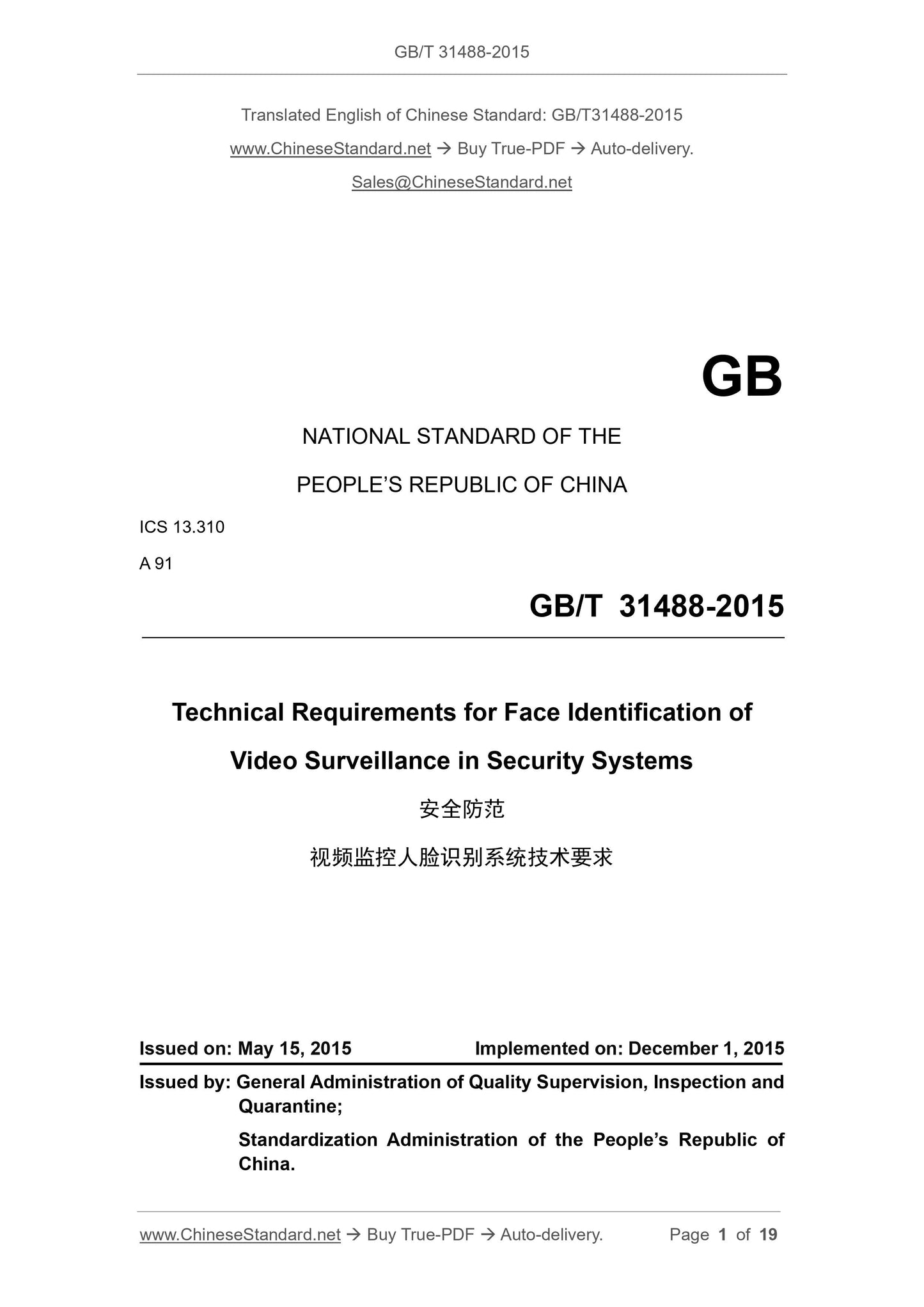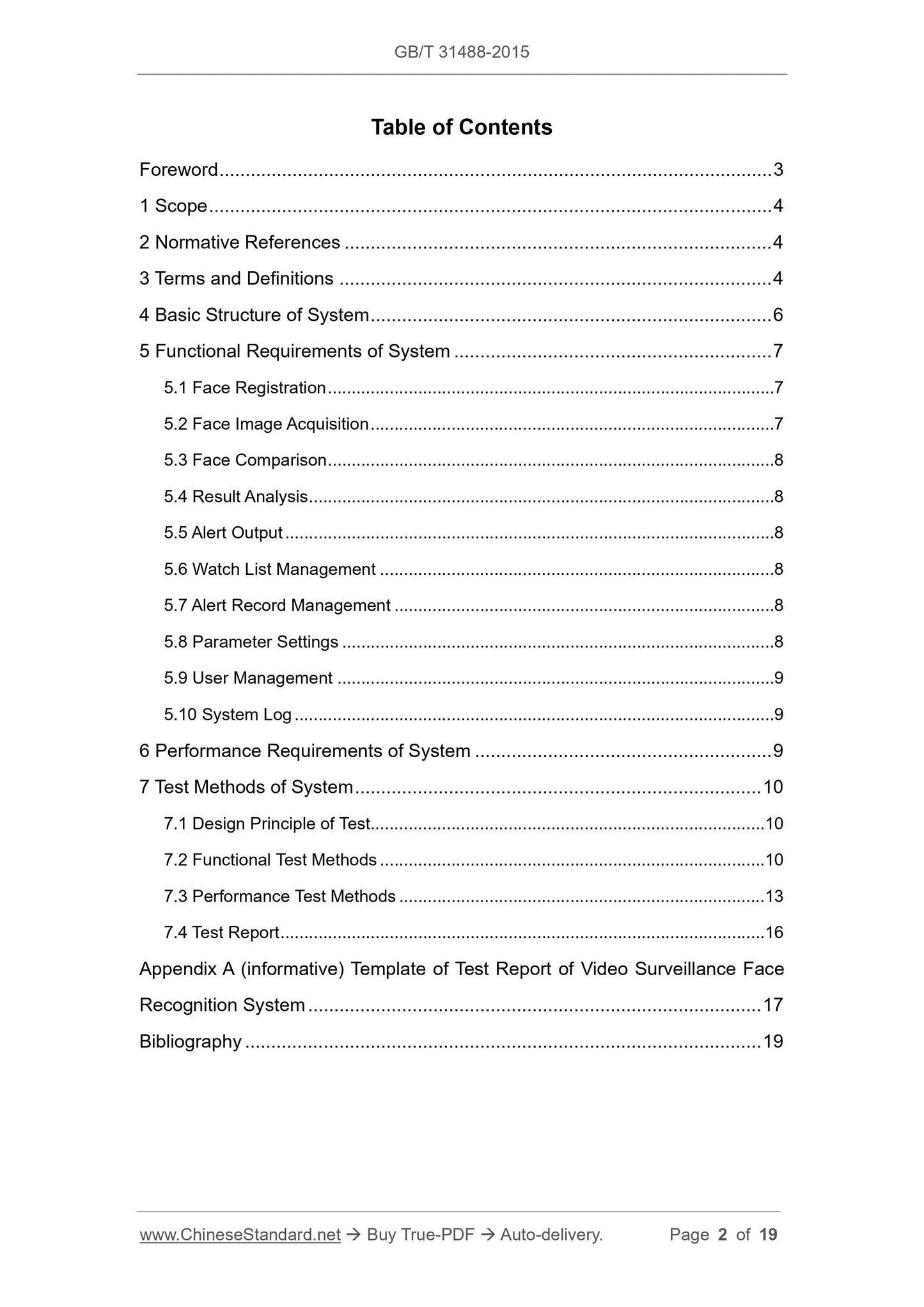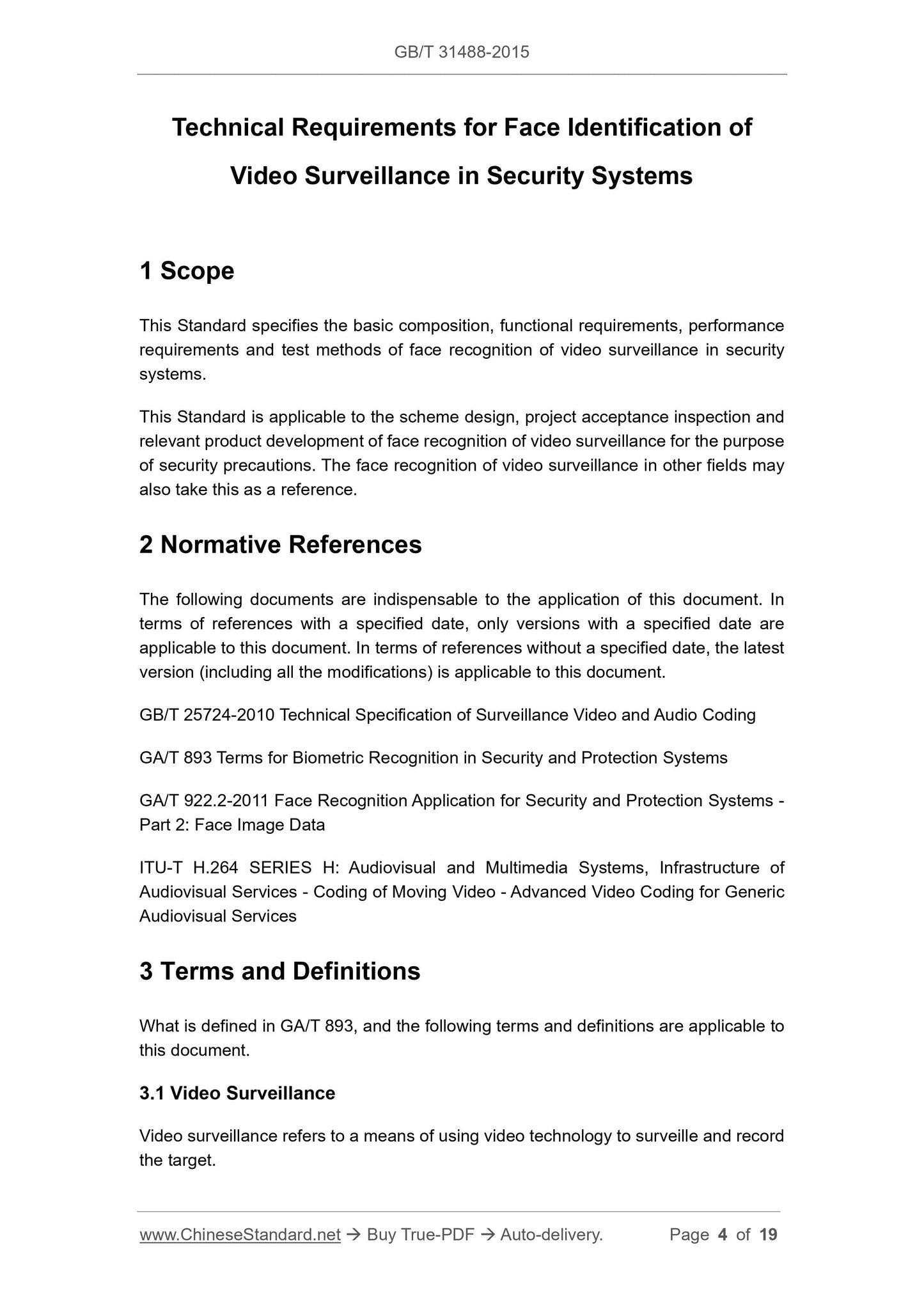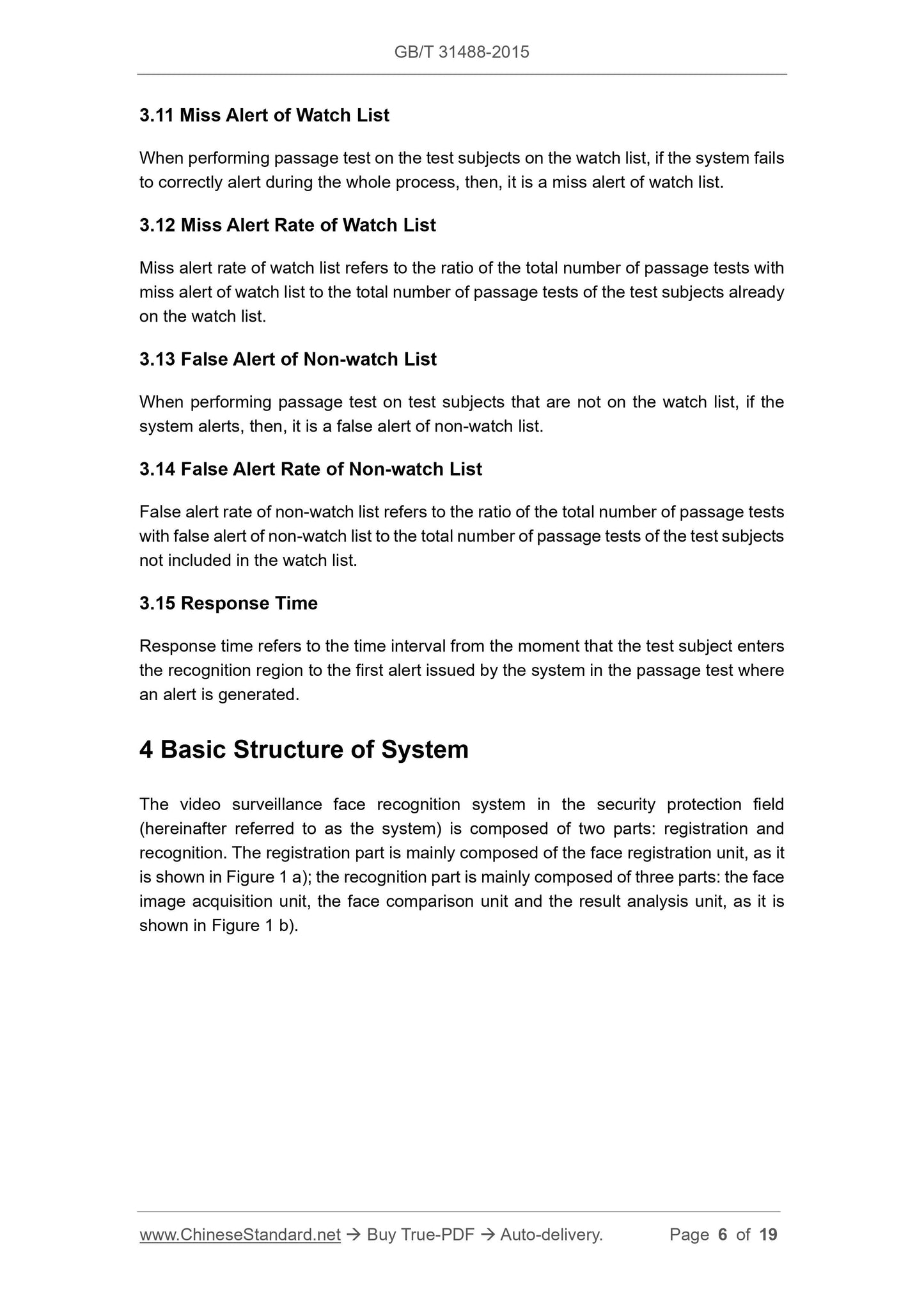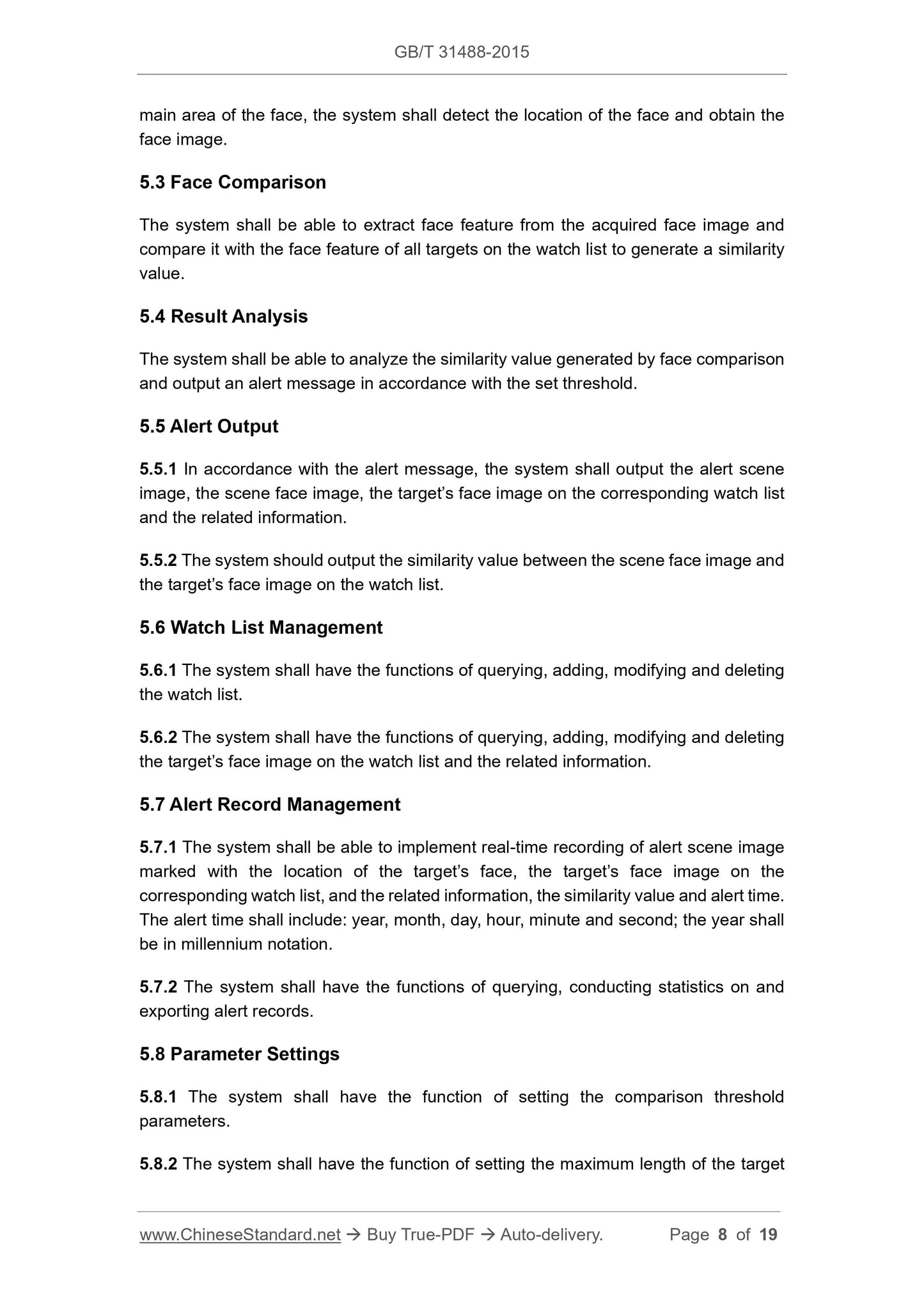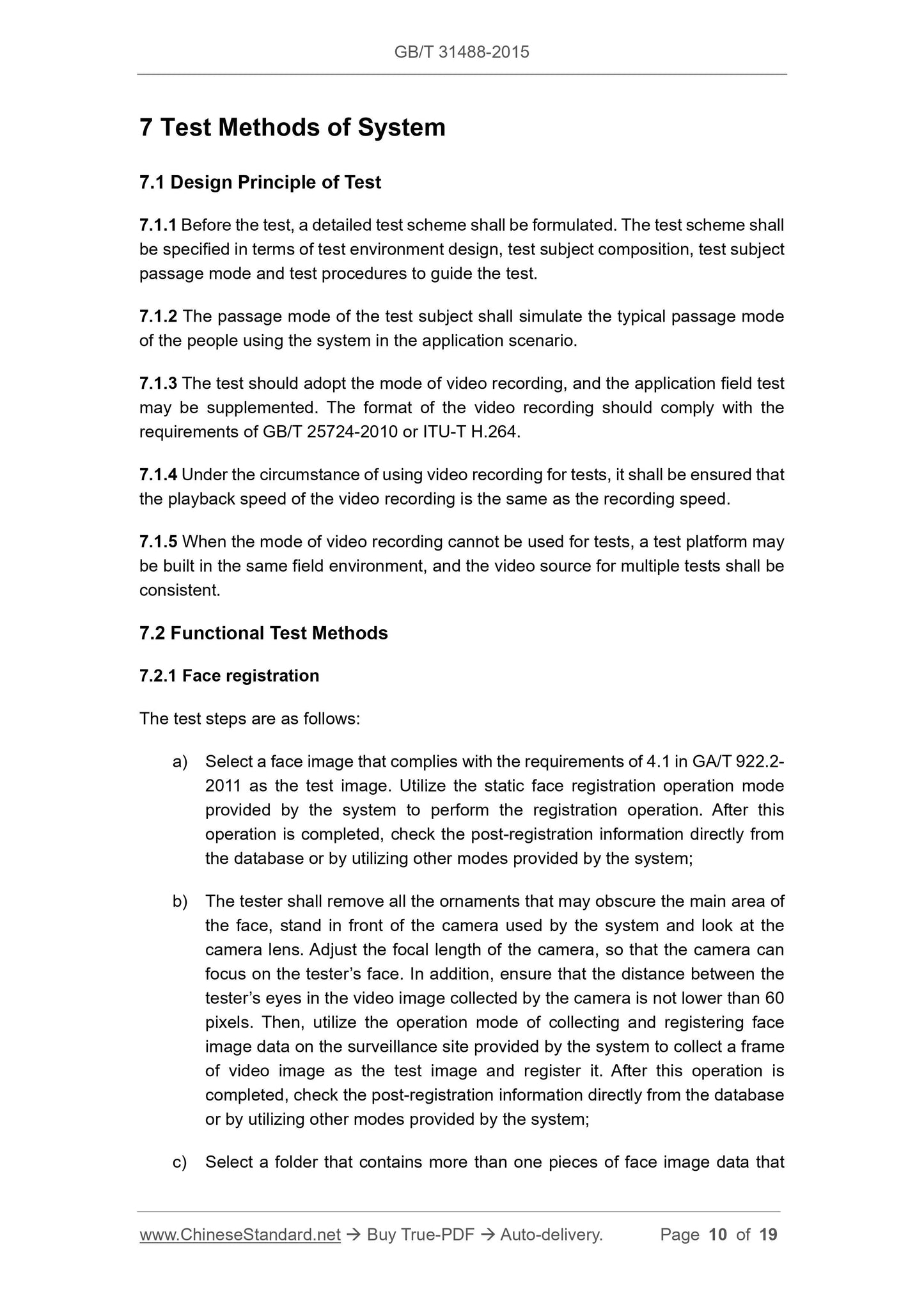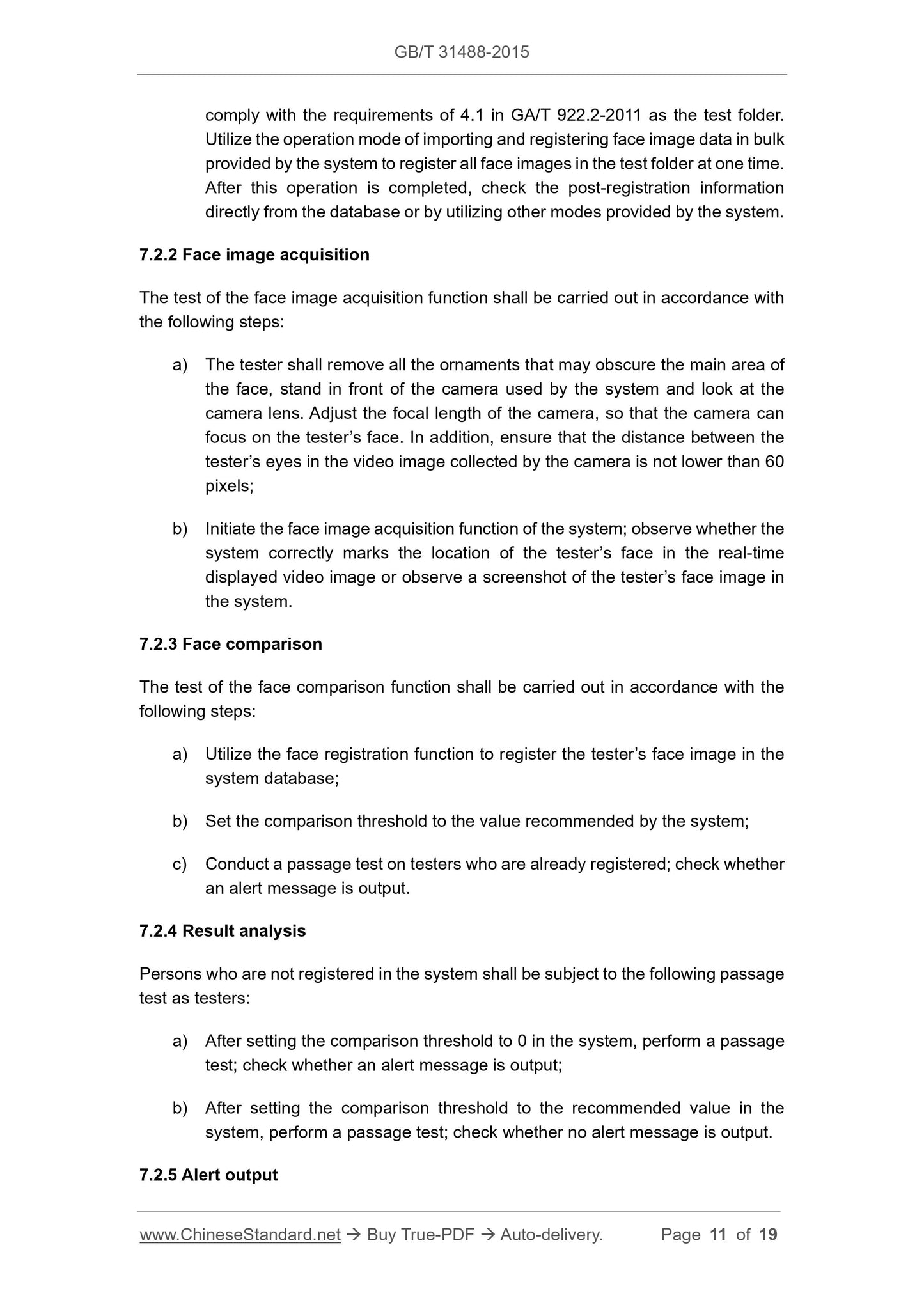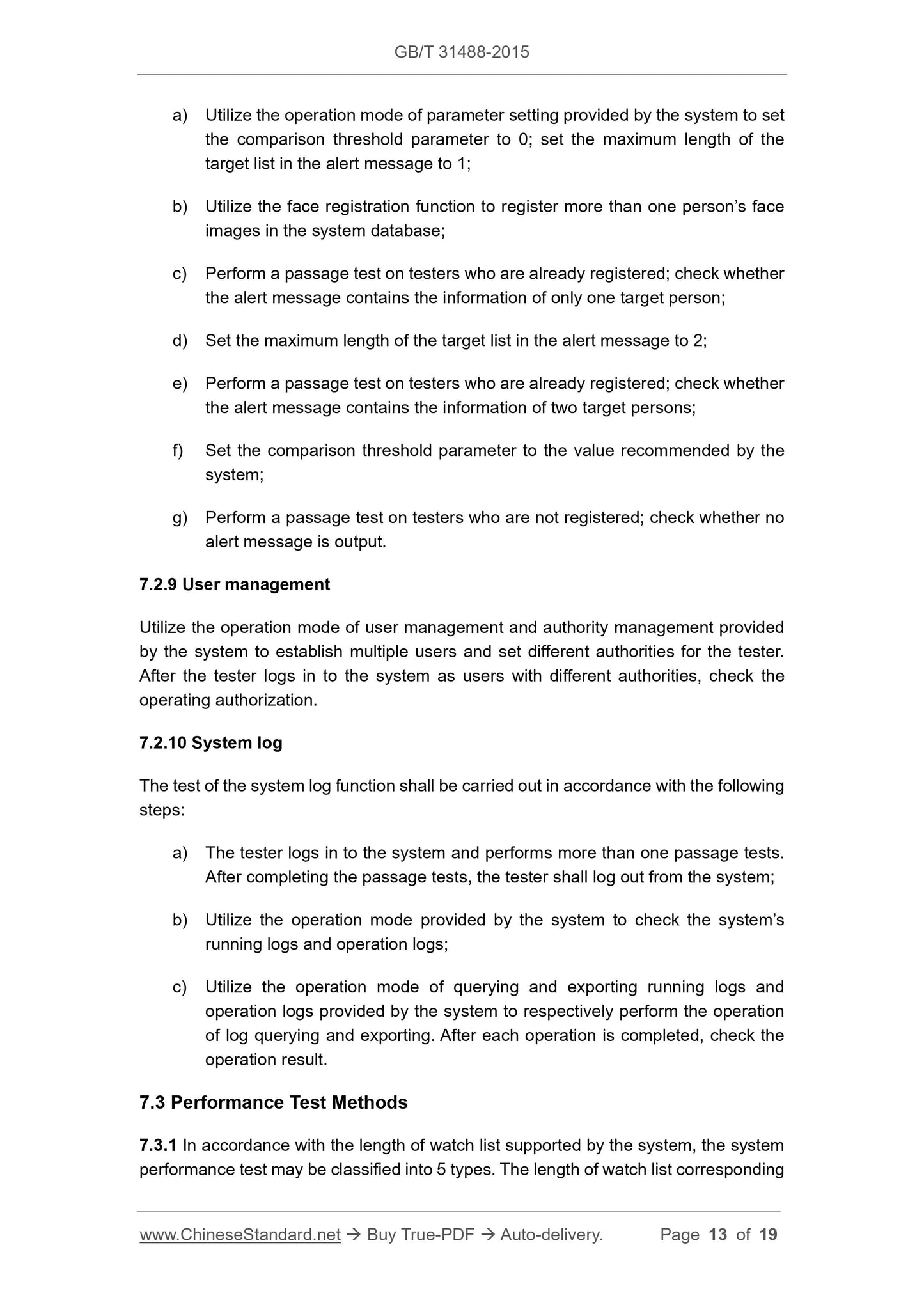1
/
of
8
PayPal, credit cards. Download editable-PDF and invoice in 1 second!
GB/T 31488-2015 English PDF (GBT31488-2015)
GB/T 31488-2015 English PDF (GBT31488-2015)
Regular price
$135.00 USD
Regular price
Sale price
$135.00 USD
Unit price
/
per
Shipping calculated at checkout.
Couldn't load pickup availability
Delivery: 3 seconds. Download true-PDF + Invoice.
Get QUOTATION in 1-minute: Click GB/T 31488-2015
Historical versions: GB/T 31488-2015
Preview True-PDF (Reload/Scroll if blank)
GB/T 31488-2015: Technical requirements for face identification of video surveillance in security systems
GB/T 31488-2015
GB
NATIONAL STANDARD OF THE
PEOPLE’S REPUBLIC OF CHINA
ICS 13.310
A 91
Technical Requirements for Face Identification of
Video Surveillance in Security Systems
ISSUED ON: MAY 15, 2015
IMPLEMENTED ON: DECEMBER 1, 2015
Issued by: General Administration of Quality Supervision, Inspection and
Quarantine;
Standardization Administration of the People’s Republic of
China.
Table of Contents
Foreword ... 3
1 Scope ... 4
2 Normative References ... 4
3 Terms and Definitions ... 4
4 Basic Structure of System ... 6
5 Functional Requirements of System ... 7
5.1 Face Registration ... 7
5.2 Face Image Acquisition ... 7
5.3 Face Comparison ... 8
5.4 Result Analysis ... 8
5.5 Alert Output ... 8
5.6 Watch List Management ... 8
5.7 Alert Record Management ... 8
5.8 Parameter Settings ... 8
5.9 User Management ... 9
5.10 System Log ... 9
6 Performance Requirements of System ... 9
7 Test Methods of System ... 10
7.1 Design Principle of Test... 10
7.2 Functional Test Methods ... 10
7.3 Performance Test Methods ... 13
7.4 Test Report ... 16
Appendix A (informative) Template of Test Report of Video Surveillance Face
Recognition System ... 17
Bibliography ... 19
Technical Requirements for Face Identification of
Video Surveillance in Security Systems
1 Scope
This Standard specifies the basic composition, functional requirements, performance
requirements and test methods of face recognition of video surveillance in security
systems.
This Standard is applicable to the scheme design, project acceptance inspection and
relevant product development of face recognition of video surveillance for the purpose
of security precautions. The face recognition of video surveillance in other fields may
also take this as a reference.
2 Normative References
The following documents are indispensable to the application of this document. In
terms of references with a specified date, only versions with a specified date are
applicable to this document. In terms of references without a specified date, the latest
version (including all the modifications) is applicable to this document.
GB/T 25724-2010 Technical Specification of Surveillance Video and Audio Coding
GA/T 893 Terms for Biometric Recognition in Security and Protection Systems
GA/T 922.2-2011 Face Recognition Application for Security and Protection Systems -
Part 2: Face Image Data
ITU-T H.264 SERIES H: Audiovisual and Multimedia Systems, Infrastructure of
Audiovisual Services - Coding of Moving Video - Advanced Video Coding for Generic
Audiovisual Services
3 Terms and Definitions
What is defined in GA/T 893, and the following terms and definitions are applicable to
this document.
3.1 Video Surveillance
Video surveillance refers to a means of using video technology to surveille and record
the target.
3.11 Miss Alert of Watch List
When performing passage test on the test subjects on the watch list, if the system fails
to correctly alert during the whole process, then, it is a miss alert of watch list.
3.12 Miss Alert Rate of Watch List
Miss alert rate of watch list refers to the ratio of the total number of passage tests with
miss alert of watch list to the total number of passage tests of the test subjects already
on the watch list.
3.13 False Alert of Non-watch List
When performing passage test on test subjects that are not on the watch list, if the
system alerts, then, it is a false alert of non-watch list.
3.14 False Alert Rate of Non-watch List
False alert rate of non-watch list refers to the ratio of the total number of passage tests
with false alert of non-watch list to the total number of passage tests of the test subjects
not included in the watch list.
3.15 Response Time
Response time refers to the time interval from the moment that the test subject enters
the recognition region to the first alert issued by the system in the passage test where
an alert is generated.
4 Basic Structure of System
The video surveillance face recognition system in the security protection field
(hereinafter referred to as the system) is composed of two parts: registration and
recognition. The registration part is mainly composed of the face registration unit, as it
is shown in Figure 1 a); the recognition part is mainly composed of three parts: the face
image acquisition unit, the face comparison unit and the result analysis unit, as it is
shown in Figure 1 b).
main area of the face, the system shall detect the location of the face and obtain the
face image.
5.3 Face Comparison
The system shall be able to extract face feature from the acquired face image and
compare it with the face feature of all targets on the watch list to generate a similarity
value.
5.4 Result Analysis
The system shall be able to analyze the similarity value generated by face comparison
and output an alert message in accordance with the set threshold.
5.5 Alert Output
5.5.1 In accordance with the alert message, the system shall output the alert scene
image, the scene face image, the target’s face image on the corresponding watch list
and the related information.
5.5.2 The system should output the similarity value between the scene face image and
the target’s face image on the watch list.
5.6 Watch List Management
5.6.1 The system shall have the functions of querying, adding, modifying and deleting
the watch list.
5.6.2 The system shall have the functions of querying, adding, modifying and deleting
the target’s face image on the watch list and the related information.
5.7 Alert Record Management
5.7.1 The system shall be able to implement real-time recording of alert scene image
marked with the location of the target’s face, the target’s face image on the
corresponding watch list, and the related information, the similarity value and alert time.
The alert time shall include: year, month, day, hour, minute and second; the year shall
be in millennium notation.
5.7.2 The system shall have the functions of querying, conducting statistics on and
exporting alert records.
5.8 Parameter Settings
5.8.1 The system shall have the function of setting the comparison threshold
parameters.
5.8.2 The system shall have the function of setting the maximum length of the target
7 Test Methods of System
7.1 Design Principle of Test
7.1.1 Before the test, a detailed test scheme shall be formulated. The test scheme shall
be specified in terms of test environment design, test subject composition, test subject
passage mode and test procedures to guide the test.
7.1.2 The passage mode of the test subject shall simulate the typical passage mode
of the people using the system in the application scenario.
7.1.3 The test should adopt the mode of video recording, and the application field test
may be supplemented. The format of the video recording should comply with the
requirements of GB/T 25724-2010 or ITU-T H.264.
7.1.4 Under the circumstance of using video recording for tests, it shall be ensured that
the playback speed of the video recording is the same as the recording speed.
7.1.5 When the mode of video recording cannot be used for tests, a test platform may
be built in the same field environment, and the video source for multiple tests shall be
consistent.
7.2 Functional Test Methods
7.2.1 Face registration
The test steps are as follows:
a) Select a face image that...
Get QUOTATION in 1-minute: Click GB/T 31488-2015
Historical versions: GB/T 31488-2015
Preview True-PDF (Reload/Scroll if blank)
GB/T 31488-2015: Technical requirements for face identification of video surveillance in security systems
GB/T 31488-2015
GB
NATIONAL STANDARD OF THE
PEOPLE’S REPUBLIC OF CHINA
ICS 13.310
A 91
Technical Requirements for Face Identification of
Video Surveillance in Security Systems
ISSUED ON: MAY 15, 2015
IMPLEMENTED ON: DECEMBER 1, 2015
Issued by: General Administration of Quality Supervision, Inspection and
Quarantine;
Standardization Administration of the People’s Republic of
China.
Table of Contents
Foreword ... 3
1 Scope ... 4
2 Normative References ... 4
3 Terms and Definitions ... 4
4 Basic Structure of System ... 6
5 Functional Requirements of System ... 7
5.1 Face Registration ... 7
5.2 Face Image Acquisition ... 7
5.3 Face Comparison ... 8
5.4 Result Analysis ... 8
5.5 Alert Output ... 8
5.6 Watch List Management ... 8
5.7 Alert Record Management ... 8
5.8 Parameter Settings ... 8
5.9 User Management ... 9
5.10 System Log ... 9
6 Performance Requirements of System ... 9
7 Test Methods of System ... 10
7.1 Design Principle of Test... 10
7.2 Functional Test Methods ... 10
7.3 Performance Test Methods ... 13
7.4 Test Report ... 16
Appendix A (informative) Template of Test Report of Video Surveillance Face
Recognition System ... 17
Bibliography ... 19
Technical Requirements for Face Identification of
Video Surveillance in Security Systems
1 Scope
This Standard specifies the basic composition, functional requirements, performance
requirements and test methods of face recognition of video surveillance in security
systems.
This Standard is applicable to the scheme design, project acceptance inspection and
relevant product development of face recognition of video surveillance for the purpose
of security precautions. The face recognition of video surveillance in other fields may
also take this as a reference.
2 Normative References
The following documents are indispensable to the application of this document. In
terms of references with a specified date, only versions with a specified date are
applicable to this document. In terms of references without a specified date, the latest
version (including all the modifications) is applicable to this document.
GB/T 25724-2010 Technical Specification of Surveillance Video and Audio Coding
GA/T 893 Terms for Biometric Recognition in Security and Protection Systems
GA/T 922.2-2011 Face Recognition Application for Security and Protection Systems -
Part 2: Face Image Data
ITU-T H.264 SERIES H: Audiovisual and Multimedia Systems, Infrastructure of
Audiovisual Services - Coding of Moving Video - Advanced Video Coding for Generic
Audiovisual Services
3 Terms and Definitions
What is defined in GA/T 893, and the following terms and definitions are applicable to
this document.
3.1 Video Surveillance
Video surveillance refers to a means of using video technology to surveille and record
the target.
3.11 Miss Alert of Watch List
When performing passage test on the test subjects on the watch list, if the system fails
to correctly alert during the whole process, then, it is a miss alert of watch list.
3.12 Miss Alert Rate of Watch List
Miss alert rate of watch list refers to the ratio of the total number of passage tests with
miss alert of watch list to the total number of passage tests of the test subjects already
on the watch list.
3.13 False Alert of Non-watch List
When performing passage test on test subjects that are not on the watch list, if the
system alerts, then, it is a false alert of non-watch list.
3.14 False Alert Rate of Non-watch List
False alert rate of non-watch list refers to the ratio of the total number of passage tests
with false alert of non-watch list to the total number of passage tests of the test subjects
not included in the watch list.
3.15 Response Time
Response time refers to the time interval from the moment that the test subject enters
the recognition region to the first alert issued by the system in the passage test where
an alert is generated.
4 Basic Structure of System
The video surveillance face recognition system in the security protection field
(hereinafter referred to as the system) is composed of two parts: registration and
recognition. The registration part is mainly composed of the face registration unit, as it
is shown in Figure 1 a); the recognition part is mainly composed of three parts: the face
image acquisition unit, the face comparison unit and the result analysis unit, as it is
shown in Figure 1 b).
main area of the face, the system shall detect the location of the face and obtain the
face image.
5.3 Face Comparison
The system shall be able to extract face feature from the acquired face image and
compare it with the face feature of all targets on the watch list to generate a similarity
value.
5.4 Result Analysis
The system shall be able to analyze the similarity value generated by face comparison
and output an alert message in accordance with the set threshold.
5.5 Alert Output
5.5.1 In accordance with the alert message, the system shall output the alert scene
image, the scene face image, the target’s face image on the corresponding watch list
and the related information.
5.5.2 The system should output the similarity value between the scene face image and
the target’s face image on the watch list.
5.6 Watch List Management
5.6.1 The system shall have the functions of querying, adding, modifying and deleting
the watch list.
5.6.2 The system shall have the functions of querying, adding, modifying and deleting
the target’s face image on the watch list and the related information.
5.7 Alert Record Management
5.7.1 The system shall be able to implement real-time recording of alert scene image
marked with the location of the target’s face, the target’s face image on the
corresponding watch list, and the related information, the similarity value and alert time.
The alert time shall include: year, month, day, hour, minute and second; the year shall
be in millennium notation.
5.7.2 The system shall have the functions of querying, conducting statistics on and
exporting alert records.
5.8 Parameter Settings
5.8.1 The system shall have the function of setting the comparison threshold
parameters.
5.8.2 The system shall have the function of setting the maximum length of the target
7 Test Methods of System
7.1 Design Principle of Test
7.1.1 Before the test, a detailed test scheme shall be formulated. The test scheme shall
be specified in terms of test environment design, test subject composition, test subject
passage mode and test procedures to guide the test.
7.1.2 The passage mode of the test subject shall simulate the typical passage mode
of the people using the system in the application scenario.
7.1.3 The test should adopt the mode of video recording, and the application field test
may be supplemented. The format of the video recording should comply with the
requirements of GB/T 25724-2010 or ITU-T H.264.
7.1.4 Under the circumstance of using video recording for tests, it shall be ensured that
the playback speed of the video recording is the same as the recording speed.
7.1.5 When the mode of video recording cannot be used for tests, a test platform may
be built in the same field environment, and the video source for multiple tests shall be
consistent.
7.2 Functional Test Methods
7.2.1 Face registration
The test steps are as follows:
a) Select a face image that...
Share
